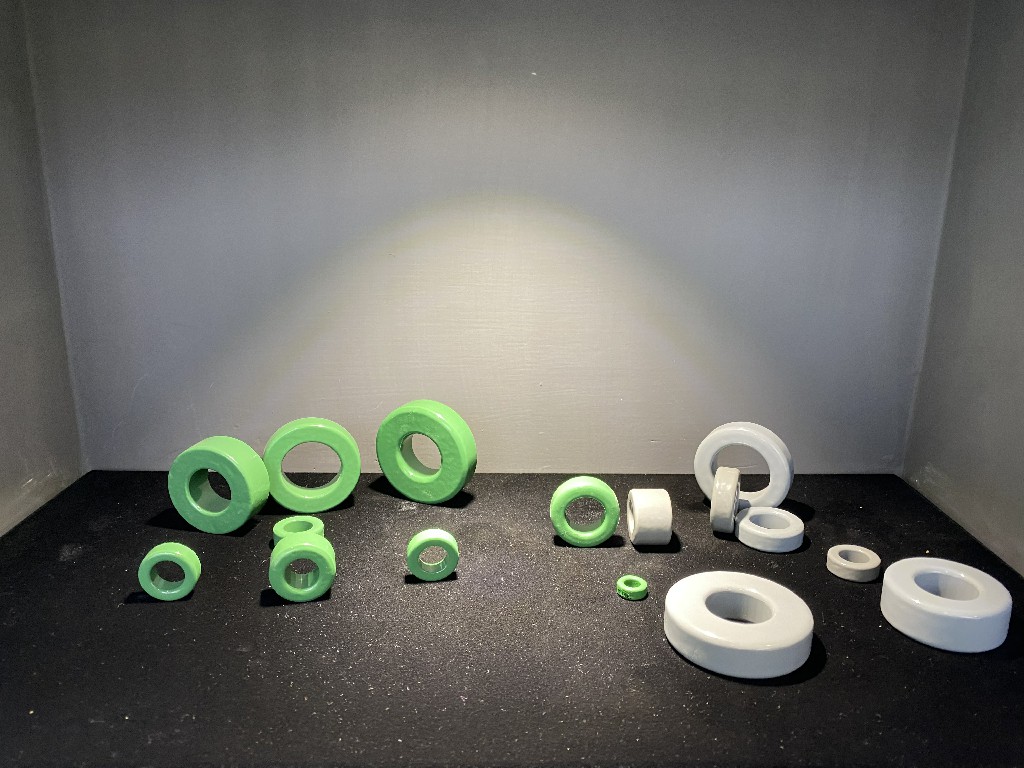Better Touch Better Business
Contact Sales at TRANSMART.
Most of the magnetic rings need to be painted for easy distinction. Generally iron powder cores are distinguished by two colors. Commonly used are red/transparent, yellow/red, green/red, green/blue and yellow/white, and manganese core rings are common. Painted green, sendust is generally black and so on. In fact, the color of the magnetic ring after firing has nothing to do with the dyeing of the paint sprayed later, it is just a convention in the industry. For example, green represents high permeability magnetic ring; two colors represent iron powder core magnetic ring; black represents sendust magnetic ring, etc.

1) High permeability ring
High permeability ring, you have to say Ni-Zn ferrite ring. Magnetic rings are divided into nickel-zinc and manganese-zinc according to the material. The magnetic permeability of nickel-zinc ferrite magnetic ring materials are currently used ranging from 15-2000. The commonly used material is nickel-zinc ferrite with a permeability of 100- Between 1000, according to the magnetic permeability classification, it is divided into low permeability materials. The magnetic permeability of the manganese-zinc ferrite magnetic ring material is generally above 1000, so the magnetic ring produced by the manganese-zinc material is called a high-permeability ring.
Nickel-zinc ferrite magnetic rings are generally used for various wire materials, circuit board ends, and anti-interference in computer equipment. Manganese-zinc ferrite magnetic rings can be used to make magnetic cores, magnetic heads and antenna rods for inductors, transformers, and filters. Under normal circumstances, the lower the material permeability, the wider the applicable frequency range; the higher the material permeability, the narrower the applicable frequency range.
(2) Iron powder core magnetic ring
Iron powder core is a popular term for the magnetic material ferroferric oxide, which is mainly used in electrical circuits to solve electromagnetic compatibility (EMC) problems. In actual application, various other substances will be added according to different filtering requirements under different bands.
Early magnetic powder cores were "bonded" metal soft magnetic cores made of iron-silicon aluminum alloy magnetic powder. People often refer to this kind of sendust magnetic powder core as "iron powder core". Its typical preparation process is as follows: use Fe-Si-Al alloy magnetic powder to undergo ball milling and flattening treatment and chemically coat the insulating layer, then add about 15wt% of the binder, mix evenly, press and solidify, and finally undergo heat treatment (to eliminate Stress) and make the product. This traditional "iron powder core" product mainly works at 20kHz∼200kHz. Because they have much higher saturation magnetic flux density than ferrites working in the same frequency band, good DC superposition characteristics, magnetostriction coefficient close to zero, no noise during operation, good frequency stability, and high cost performance. It has been widely used in electronic components such as high-frequency electronic transformers. Their disadvantage is that non-magnetic fillers not only produce magnetic dilution, but also make the magnetic flux path discontinuous, and local demagnetization leads to a decrease in magnetic permeability.
The recently developed high-performance iron powder core is different from the traditional sendust magnetic powder core. The raw material used is not alloy magnetic powder but pure iron powder coated with an insulating layer. The amount of binder is very small, so the magnetic flux density is increased. Increased. They work in the low and medium frequency bands below 5kHz, generally several hundred hertz, which is much lower than the working frequency of sendust magnetic powder cores. The target market is to replace silicon steel sheets used in motors with its advantages of low loss, high efficiency and easy three-dimensional design.
(3) Sendust magnetic ring
Sendust magnetic ring is one of the most used magnetic rings. Simply put, sendust is composed of aluminum-silicon-iron and has a very high Bmax (Bmax is the average maximum magnetic core cross-sectional area Flux density.), its core loss is much lower than iron powder core and high magnetic flux, low magnetostriction (low noise), low-cost energy storage material, no thermal aging, can be used to replace iron powder core , Its performance is very stable at high temperature.
The most important feature of Sendust is that it has lower loss compared to iron powder core and has good DC bias current characteristics. The price is not the highest, but not the lowest, compared with the iron powder core and Fe-Ni-Mo.
Sendust magnetic powder core has excellent magnetic properties, low power loss, high magnetic flux density, when used in the temperature range of -55C~+125C, it has high reliability such as temperature resistance, humidity resistance, and vibration resistance;
At the same time, a wide permeability range of 60~160 is available. It is the best choice for switching power supply output chokes, PFC inductors and resonant inductors, and has a higher cost performance.
Copyright © 2025 TRANSMART INDUSTRIAL LIMITED | All Rights Reserved
Hello, please leave your name and email here before chat online so that we won't miss your message and contact you smoothly.